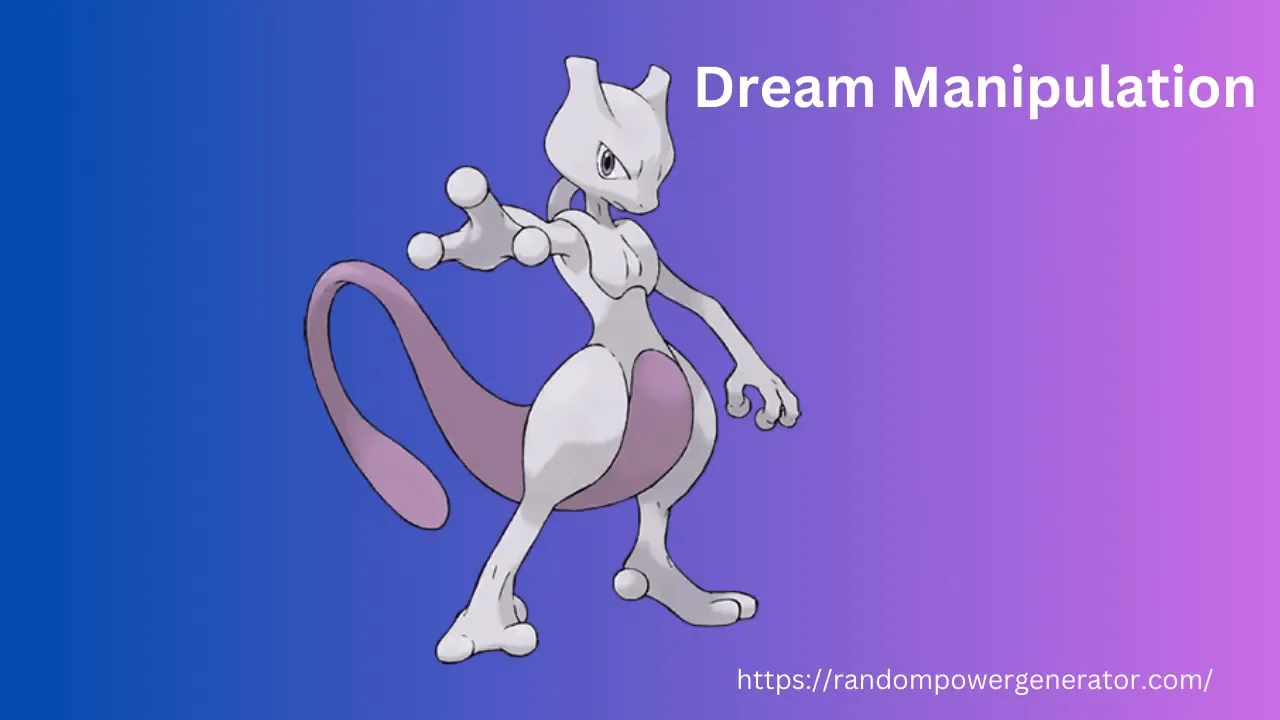Oneirokinesis | Dream Manipulation

In stories, we often encounter amazing abilities. One of these is oneirokinesis, the power to control dreams. You might have seen it in anime, books, or superhero movies like those from DC or Marvel. In this article, we’ll explore oneirokinesis—what it is, where it comes from, and why it’s so fascinating in stories. Let’s dive into the magical world of dreams and uncover the secrets of this superpower.
Oneirokinesis is the ability to control or manipulate dreams. It allows individuals to shape and influence their subconscious experiences of themselves or others during sleep.
Alternative Names of Oneirokinesis
These are some common terms used to describe abilities related to manipulating or interacting with dreams.
- Dream Manipulation
- Dream Control
- Dreamwalking
- Oneiric Manipulation
- Dream Projection
- Oneiric Projection
- Oneiric Mastery
- Oneiric Influence
- Dreamweaving
- Oneiric Sovereignty
Capabilities
Abilities related to dream manipulation share several general capabilities:
-
Dream Alteration: Characters can change the content, environment, or events of dreams according to their will.
-
Dream Interaction: Characters can interact with dream elements, characters, or environments, either as observers or active participants.
-
Dream Creation: characters have the ability to create entirely new dreams or dreamscapes, shaping them from their imagination.
-
Dream Perception: Users possess enhanced perception or awareness within dreams, allowing them to navigate, explore, and understand dream environments more effectively.
-
Dream Influence: characters can influence the thoughts, emotions, or experiences of dreamers, either subtly or overtly, by manipulating dream content.
-
Dream Projection: Users can project their consciousness or presence into dreams, appearing as entities or manifestations within dreamscapes.
-
Dream Communication: Users can communicate with dreamers through telepathic or symbolic means, conveying messages or information within their dreams.
Applications
Abilities related to dream manipulation offer diverse practical uses:
-
Thematic Dreamscapes: Characters can create dream worlds tailored to specific themes or narratives, providing immersive experiences for themselves or others.
-
Character Development: Dream manipulation can serve as a storytelling device for character development, allowing characters to confront their fears, explore their past, or discover hidden aspects of their personalities within dream sequences.
-
Plot Advancement: Dreams can be used as a narrative tool to advance the plot, foreshadow future events, or reveal key information through symbolic imagery or cryptic messages.
-
Psychological Warfare: Characters with dream manipulation abilities can engage in psychological warfare by infiltrating the dreams of adversaries, inducing nightmares, or manipulating perceptions to gain strategic advantages in conflicts.
-
Dreamscape Exploration: Dream manipulation opens up possibilities for exploring surreal and fantastical dreamscapes, uncovering hidden treasures, encountering mythical creatures, or embarking on epic quests within the realm of dreams.
-
Parallel Realities: Dreams can be depicted as parallel realities or alternate dimensions, where characters navigate through dreamscapes that mirror or diverge from the waking world, blurring the lines between reality and fantasy.
-
Existential Exploration: Dream manipulation can prompt characters to ponder existential questions about the nature of reality, consciousness, and the subconscious mind, leading to philosophical contemplation and introspection.
You can check out our random superpower generator for untapped and unique superpower ideas.
Associations
In anime and fiction, dream manipulation abilities often intersect with other powers or concepts, creating intriguing connections and relationships:
-
Telepathy: Dream manipulation abilities frequently overlap with telepathic powers, as users must enter the minds of others to manipulate their dreams or communicate within dreamscapes.
-
Illusion Manipulation: Dream manipulation shares similarities with illusion-based powers, as both involve creating and manipulating sensory perceptions and imaginary constructs.
-
Reality Warping: Advanced dream manipulation abilities may extend into reality warping, allowing users to bend or alter reality itself based on their dream experiences or perceptions.
-
Psychic Powers: Dream manipulation is often categorized as a form of psychic ability, as it involves the manipulation of mental and subconscious processes to control dreams.
-
Time Manipulation: Some dream manipulation abilities may involve aspects of time manipulation, allowing users to alter the flow of time within dreams or perceive events from different temporal perspectives.
-
Emotion Manipulation: Dream manipulation can influence the emotions and psychological states of dreamers, similar to emotion-based powers that directly manipulate feelings and moods.
-
Parallel Realities: Dream manipulation abilities may blur the lines between dreams and alternate realities, exploring themes of parallel dimensions, alternate timelines, and the nature of reality itself.
-
Chlorokinesis Superpower: Characters with this superpower can control and manipulate wood, rock soil, roots, fruits, flowers, and even moss found in natural fields.
-
Hydrokinesis: hydrokinesis allows characters to shape, move, and control water effortlessly.
-
Metal Manipulation: Metal manipulation is the supernatural ability to control, shape, or influence metallic substances through extraordinary superpowers.
Limitations
In anime, fiction, and related media, dream manipulation abilities have their own limitations:
-
Dreamer’s Willpower: Characters with strong willpower may resist manipulation attempts, requiring users to find alternative ways to enter their dreams.
-
Dream Realm Instability: Dreamscapes can be unpredictable, making it challenging for users to control or navigate them.
-
Psychic Interference: Other psychic entities or forces in the dream realm may interfere, creating obstacles for users.
-
Physical Consequences: Actions in dreams may affect the real world, posing risks for both dreamers and users.
-
Limited Control: Users may have limited influence over certain aspects of dreams.
-
Dreamer’s Consciousness: Dream manipulation works best when the dreamer is asleep or in an altered state of consciousness.
-
Mental Strain: Excessive use of abilities may tire users, reducing their effectiveness or leaving them vulnerable.
Known Users
In the rich tapestry of anime, fiction, and related media, various characters wield dream manipulation abilities:
-
Morpheus (The Sandman): A key figure in Neil Gaiman’s “Sandman” series, Morpheus is the embodiment of dreams and controls the Dreaming, a realm where all dreams reside.
-
Freddy Krueger (A Nightmare on Elm Street): The iconic horror villain, Freddy Krueger, haunts the dreams of his victims, manipulating and tormenting them in their nightmares.
-
Yumemi Yumemite (Planetarian): In the visual novel and anime series “Planetarian,” Yumemi possesses the ability to project dreams into the minds of others, offering them solace in a post-apocalyptic world.
-
Pegasus J. Crawford (Yu-Gi-Oh!): Known as Maximillion Pegasus in the English version of the series, Pegasus possesses the Millennium Eye, which grants him the power to invade and manipulate the dreams of others.
-
Dream Eaters (Kingdom Hearts): Creatures from the “Kingdom Hearts” series, Dream Eaters feed on dreams and nightmares, exerting influence over the dream realm and the hearts of dreamers.
-
Mewtwo (Pokémon): The powerful psychic Pokémon, Mewtwo, has been depicted as capable of entering and manipulating the dreams of others, using its psychic abilities to influence their subconscious minds.
-
Inceptionists (Inception): In the film “Inception,” characters known as inceptionists specialize in the art of planting ideas or extracting information from the dreams of their targets.
Conclusion
Oneirokinesis, the ability to manipulate dreams, adds depth and intrigue to anime and fiction. From Freddy Krueger’s nightmares to Morpheus’ dreaming, dream manipulation offers limitless storytelling potential. It reflects our subconscious desires and fears, enriching characters and plots.
Dream manipulation is a powerful tool for healing, inspiration, and adventure. It transports us to realms of wonder, blurring the lines between reality and imagination. As we explore the possibilities of oneirokinesis, we discover the true power of dreams to shape our stories and our lives.
